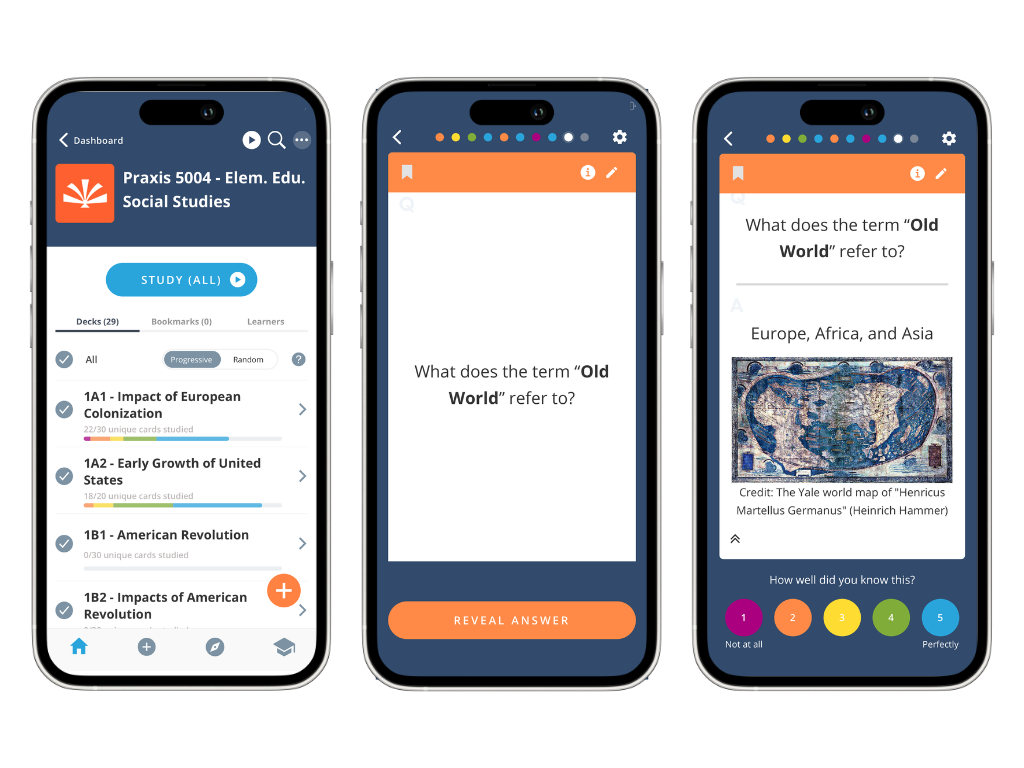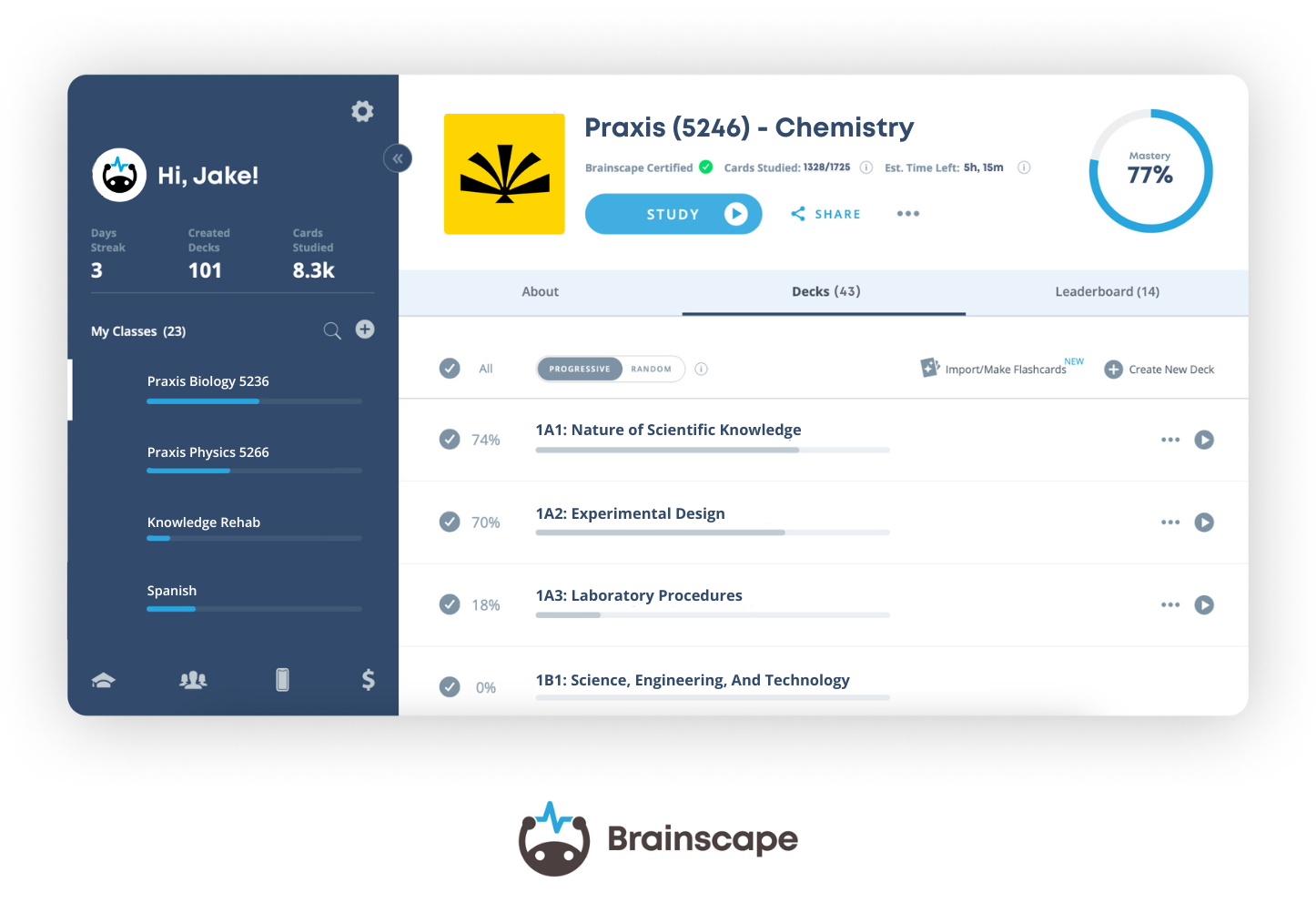Like Frodo Baggins’ epic journey to Mordor, your path to becoming an educator is a noble one (minus a few grumpy orcs). And the Praxis Elementary Education: Social Studies Subtest (5004) is one of several quests you’ll need to complete to reach the summit of your ambitions. The Praxis 5004 is intended to evaluate the social studies knowledge and skills that are vital for an elementary school teacher.
Since Brainscape is the purveyor of the world’s finest (and most effective) flashcards for this exam, we dug into our collective wisdom—as well as seeking the advice of ETS Praxis itself—to create this Praxis 5004 study guide to help you prepare for, and crush the Elementary Education: Social Studies Subtest, especially if you’re a repeat test-taker.
This social studies study guide kicks off with the key preparations you should make before diving into the most efficient study methods that are best-suited for this exam. We’ll then wrap up with the right ways to treat your brain and your body so that you can sail through this a whole lot more smoothly than Mr. Baggins did on his quest.
In other words, adhere to this advice, put in the study time, and…
For advice on Praxis's other exams, check out the following guides and flashcard packs:
- Study guide: Praxis Elementary Education: Science (5005)
- Flashcards: Praxis Elementary Education: Science (5005)
- Study guide: Praxis Biology (5236)
- Flashcards: Praxis Biology (5236)
- Study guide: Praxis Social Studies: Content Knowledge (5081)
- Flashcards: Praxis Social Studies: Content Knowledge (5081)
Tip # 1: Know what to expect from Praxis’s Elementary Education: Social Studies Subtest (5004)
Praxis’s Elementary Education: Social Studies Subtest (5004) is a 60-minute, multiple-choice exam with approximately 60 questions divided across three content categories:
- United States History, Government, and Citizenship: 27 questions (45%)
- Geography, Anthropology, and Sociology: 18 questions (30%)
- World History and Economics: 15 questions (25%)
Your key takeaways from this are:
- You should devote approximately 45% of your study time to United States History, Government, and Citizenship; 30% to Geography, Anthropology, and Sociology; and 25% to World History and Economics.
- During the exam, you’ll have one minute per question, which is plenty of time if you’re prepared.
- Multiple-choice might seem easier than answering questions from scratch but just remember that having more options to choose from can make answering more complicated. You need to know the facts.
Bear these in mind as you approach your Praxis 5004 exam prep.
Oh, and totally check out this video by someone who has hiked the same path you're currently on!
Tip # 2: Start with a 30,000-foot view of your studies
At the outset of your studies, it really helps to establish a 30,000-foot view of the Praxis Elementary Education Social Studies 5004 test outline and the content you need to cover. Once you’ve done that, you can plot out a well-informed roadmap to get you from where you are today to fully prepared and confident.
One way you can do that is by breaking down the course materials into daily, weekly, or even monthly goals using these study planner and exam countdown templates, which we’ve put together for you. (They’re completely free: no strings attached. Just follow the instructions laid out, choose the template you like, create a copy of it, and then fill it out to meet your own study goals.)
The value of this planning is that it primes your brain for learning, while setting a schedule that will keep you on track to cover everything you need to study in time for your test date.
Pro Tip: In your study schedule, leave yourself plenty of time to revise older material! At least 20% of the studying you do every day should be devoted to reviewing the stuff you previously covered. Our Praxis Elem. Ed. Social Studies (5004) flashcards do this automatically by regularly testing you on previously-covered concepts… but more on that in a bit.
Tip # 3: Take a practice test early on in your prep
Another way you can get a solid perspective on the challenge ahead of you is to practice answering the kind of questions you can expect to see on exam day. Thankfully, Praxis’s Elementary Education: Social Studies (5004) course comes with a free practice test, and another two available for purchase. Check them out here:
Praxis Elementary Education: Social Studies (5004) Practice Tests
The key tip here is to take the first practice test early on in your prep so that you can go into your studies knowing what you’re studying for.
Don’t expect to know the answers! You won’t because at this point, you haven’t covered much of the material. That’s not the point so don’t feel discouraged if you cannot answer most of the questions. Rather, this early practice will help you understand how Praxis will be testing you at the end of your course, and this will be invaluable to your preparation.
Then, closer to exam day, retake the test (the one you did early on) followed by the other practice test. Importantly, do them under timed conditions so that you learn to manage your time properly, while flexing your content knowledge.
Tip # 4: Use digital flashcards to learn much faster

Flashcards (done right) are the fastest, most efficient and painless way to ingrain and retain the mountain of facts tested by Praxis’s Elementary Education: Social Studies Subtest (5004). And so our second tip is really our ultimate tip on easily studying and passing with flying colors.
Study efficiently with digital flashcards. Seriously.
(You can find an already-made, expert-vetted collection of flashcards for Elementary Education: Social Studies Subtest (5004), which we created in partnership with ETS Praxis.)
The content tested in this exam was made for flashcards. Here’s why:
Each Praxis 5004 exam question tests you on a single concept, a discrete unit of knowledge, for example:
Which of the following major world religions is monotheistic?
(A) Hinduism
(B) Buddhism
(C) Islam
(D) Shintoism
Which of the following mountain ranges cross through the state of Washington?
(A) The Cascades
(B) The Himalayas
(C) The Appalachians
(D) The Alps
What percentage of the seats in the United States House of Representatives is up for election every two years?
(A) 33%
(B) 50%
(C) 66%
(D) 100%
Answers: C, A, D
Framed as short questions and answers, these concepts fit perfectly into flashcard format, even paper flashcards. Of course, we prefer to save the trees and stick to digital flashcards like you’ll find in the Brainscape app:

Even better, we’ve broken down the entire Elementary Education: Social Studies (5004) curriculum into this collection of 600 flashcards. These cover all of the highest-yield concepts you need to know, with all the fluff left out. They’ve also been neatly-organized into decks that align with Praxis’s 5004 test outline, with study metrics provided every step of the way so you always have a finger on the pulse of your progress.
Armed with this study tool, you can study online or via the app anytime, anywhere with a spaced repetition learning algorithm that is optimized for your retention of the key facts.
Speaking of spaced repetition…
Tip # 5: Study efficiently with spaced repetition
The brain is designed to learn things over time, with repetition. The more “hooks” you establish for a piece of knowledge, the more likely you are to remember it. That’s why you can pretty easily recall your phone number—a random sequence of 10 numbers—without much effort at all: because you use it all the time!
The problem is, reading, re-reading, and re-reading your notes is a horribly inefficient and time-consuming way to study for Praxis’s Elementary Education: Social Studies Subtest (5004). Flashcards, on the other hand, are the perfect vehicle for the spaced repetition of the facts you need to know. But there’s much more sophistication to digital flashcards that paper flashcards could never replicate (nevermind the fact that you have to actually make paper flashcards yourself, and ain’t nobody got time for that.)
Brainscape has engineered a study algorithm—a delivery system—for the facts that tailors itself precisely to YOUR rate of learning: saving you time on the facts you already know well, while drilling you again and again on those you’re a little rusty on. In other words, Brainscape delivers content to you in a way that is optimized for your brain’s retention of that knowledge.
Curious? Here’s how it works…
Using Brainscape to study for Praxis’s Elementary Education: Social Studies Subtest (5004)
If you’ve used Brainscape before and are familiar with how the app works, you can skip this section and head straight to our next tip. In fact, the app is so easy and intuitive to use you could probably skip this section regardless. However, if you’d like a mini-tutorial on how Brainscape works to help you efficiently learn for Praxis’s Elementary Education: Social Studies Subtest (5004), the following explanation will prove helpful to you…
First, make sure you go to Brainscape.com—and/or download the Brainscape app (available on both iOS and Android)—and create an account for yourself. Then, once you’re logged in, search for our Praxis 5004 flashcards and hit the orange “Start studying” button.
This will port all of these flashcards over to your dashboard, where you can start studying them.
Tap the “Study” button and you will be shown your first flashcard question, which you should attempt to answer in your head or out loud. To see the answer, tap the “Reveal” button.
This will not only show you the correct answer to the question, but will also prompt you to rate how well you knew the answer on a scale of 1 to 5, with 1 being “not at all” and 5 being “completely”.
If you rate your confidence a ‘1’ or ‘2’, Brainscape’s spaced repetition algorithm will repeat that flashcard in a short amount of time, drilling you on that concept again and again until it becomes ingrained in your memory. 4’s And 5’s, on the other hand, get repeated much less frequently, essentially saving you time on the concepts you already know well.
In this way, Brainscape systematically and efficiently helps you build your knowledge from the ground up, relentlessly attacking any weaknesses, while progressing smoothly through the concepts you already understand well.
Tip # 6: Lean on plenty of visual aids
It’s one thing to learn in black-and-white text all the facts you need to know to pass the Praxis Elementary Education: Social Studies Subtest (5004). It’s another experience entirely to be able to SEE the key historical events, characters, geographical features, and social and economic concepts that the curriculum teaches, whether it’s in a photo, painting, illustration, map, or some other kind of graphical representation.
(This is exactly why we’ve included so many images in our Praxis 5004 Social Studies flashcards: to improve impact and retention even further.)
That said, Google is your friend: use it.
Google Maps are particularly useful for helping you locate and visualize the various topographical features and historic places you’re required to learn about.
You can even add images to the flashcards you’ve made yourself (because you can do that in Brainscape and it’s a whole lot of fun). That said, you should find everything you need in our expert-made and vetted collection of Praxis 5004 flashcards.
Tip # 7: Prepare your body and brain for exam performance
Do you think Frodo Baggins would have made it to Mordor if he was up late every night, pounding back the mulled cider, and living on scones and clotted cream? NO! Sleep, nutrition, and hydration are crucial for a healthy body and a healthy brain that will ally themselves to your cause, which is to pass the Praxis Elementary Education: Social Studies Subtest (5004).
At this point, you should know what a healthy, balanced diet looks like (although you’ll find some study snack ideas and tips here). But a surprising number of students have no idea just how badly a lack of sleep, proper hydration, and exercise is impacting their academic performance. (It goes without saying that alcohol is included in this equation.)
Think of it this way: if you want your car to run efficiently, you’ve got to give it the right fuel. The same applies to your brain.
Studying on very little sleep, fueled by caffeine and cheap instant noodles, will make learning a nightmare. You probably won’t feel like it half the time, and struggle to concentrate when you do.
But when you’re well-rested and hydrated, and have eaten well—and maybe even started the day with a little exercise—learning is a totally different experience. You’ll feel much more motivated and focused, and you’ll be able to study for longer and retain more of what you learn.
Trust me. Give your brain what it needs to operate properly and you will be amazed by what you can do.
We’ve written a full guide on how to optimize your brain health for effective studying, so definitely check that out.
Tip # 8: Equip yourself with the right test-taking strategies
You’ve got a study plan and you’ve got the right tools. But while your whole mind has, to this point, been consumed by preparation, you should also spare a thought for exam day. Why? Because you could study your butt off and still crash and burn… all because you got lost on the way to the venue, or because you didn’t pay attention to some critical instruction, or you ran out of time halfway through the exam.
There’s a skill to taking exams, not only when it comes to time management but also to planning ahead for logistics. We cover all of the possible pitfalls and strategies in our guide ‘The 20 best test-taking strategies’—so I recommend you read that—but here are five hard-and-fast tips you should pay attention to:
- Arrive at the exam venue 30 minutes early. The last thing you need is the utter panic of getting lost, missing your bus, or getting stuck in a traffic jam.
- Avoid other stressed-out students like they have the ebola virus. Stress is contagious, and no matter your state of preparation, you’re better off staying in your headspace.
- Read the exam instructions carefully. Possibly the dumbest thing you can do in any test or exam is leave points on the table because you didn't listen to the examiner or read their instructions.
- Read the exam questions carefully. Multiple-choice questions can be notoriously tricksy, throwing out several correct-sounding answers but only one will answer the actual question.
- If you don’t know the answer, guess! Praxis doesn’t penalize incorrect answers so you may as well! As Michael Jordan said: “You miss 100% of the shots you don’t take.” (Or was that Gretzky 🤔)
- We cover a lot more test-taking strategies in that article I shared with you so please do check it out, especially if you tend to suffer from anxiety. There’s a lot in there about how to talk yourself off a ledge, if you’re having a bit of a panic during the exam.
A final note on passing Praxis’s Elementary Education: Social Studies Subtest (5004)

Ultimately, all of the advice we gave you in this guide—pre-studying preparation, digital flashcards, visual aids, exam day strategies, etc.—is applicable to ALL of Praxis’s Elementary Education subtests, not to mention their other assessments.
Each constitutes the leg of a journey you must take to complete your ultimate quest: becoming an educator. And now that you have the best possible counsel, grab the right study tools, and rise to your challenge!
Other study guides you’ll find super useful:
In the Brainscape Academy, we’ve got a whole library of advice on studying, taking exams, and just generally being an epic, lifelong learner, so take a look through some of the topics and frequently-asked questions there. Here are some of the guides I think will be particularly useful to you as you prepare to take Praxis’s Elementary Education: Social Studies Subtest (5004):
- How to study effectively: The ultimate guide
- How to focus while studying: Tips for better concentration
- How to stop being TIRED and study NOW
Praxis and Brainscape have also released flashcards and study guides for the following Praxis exams (with more on the way):
Praxis Elementary Education: Science (5005):
Praxis Biology (5236):
Praxis Social Studies: Content Knowledge (5081)
More coming soon!
